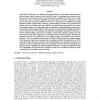Free Online Productivity Tools
i2Speak
i2Symbol
i2OCR
iTex2Img
iWeb2Print
iWeb2Shot
i2Type
iPdf2Split
iPdf2Merge
i2Bopomofo
i2Arabic
i2Style
i2Image
i2PDF
iLatex2Rtf
Sci2ools
BCS
2008
2008
Hardware Dependability in the Presence of Soft Errors
Using formal verification for designing hardware designs free from logic design bugs has been an active area of research since the last 15 years. Technology has matured and we have a choice of formal tools such as model checkers, equivalence checkers, and a range of theorem provers. Hardware reliability and fault tolerance has been studied for a long time as well, and some good solutions in the form of redundancy are available for making hardware resilient against faults. However, understanding the impact of a particular kind of fault known as a single-event-upset (SEU) or a transient fault especially in the context of low-power design is not well understood, and therefore achieving adequate tolerance for low-power processors against SEUs is still very much an open problem. A significant bottleneck in this has been the traditional fault injection methodology whereby the impact of a fault is analysed whilst a processor is running a specific binary program image. Thus the true impact of...
| Added | 29 Oct 2010 |
| Updated | 29 Oct 2010 |
| Type | Conference |
| Year | 2008 |
| Where | BCS |
| Authors | Ashish Darbari, Bashir M. Al-Hashimi |
Comments (0)

